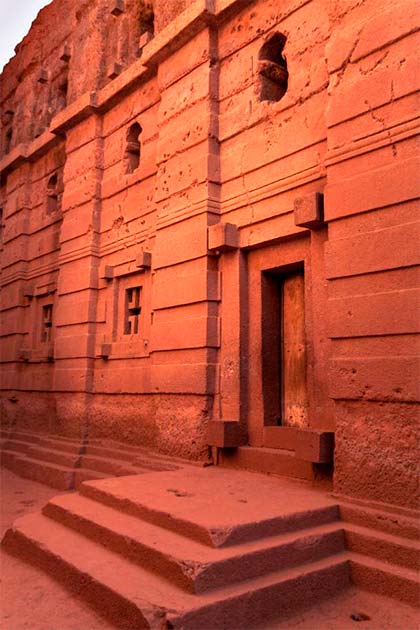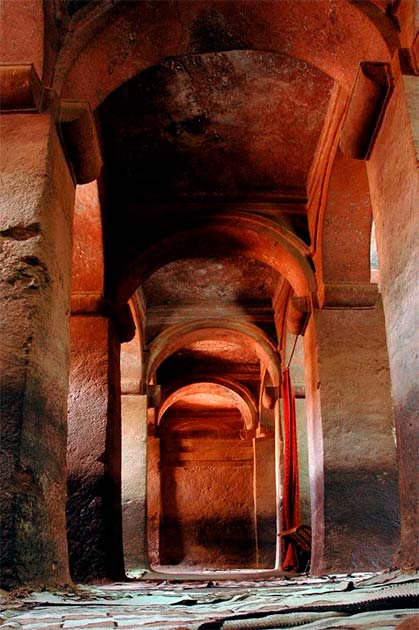The Astonishing Architecture of Lalibela’s Monolithic Rock-Hewn Churches
In the heart of Ethiopia, there lies a town of unparalleled beauty and wonder. Lalibela is home to eleven monolithic rock-hewn churches, the largest of their kind in the world, which have been standing for at least 800 years. They are a UNESCO World Heritage site, and while much is known about their history, there are still many unanswered questions about their construction. Legends speak of an angel who requested their creation, while modern-day archaeologists are baffled by the tools and techniques used to create them.

Located in the Amhara Region of Ethiopia, approximately 370 miles (600 kilometers) north of Addis Ababa, Lalibela sits at an elevation of 8,200 feet (2,500 meters). At the heart of the town is an extraordinary complex of 11 monolithic churches, believed to have been carved out of the living rock around 800 years ago. The churches are believed to have been built during the reign of King Lalibela (1181-1221) of the Zagwe dynasty, who aimed to establish a new Jerusalem on African soil that would be accessible to all Ethiopians. The names of the churches and their features are reminiscent of those in Jerusalem, such as the river Jordan, the church of Golgotha, and the Tomb of Adam.
However, David Philipson, professor of African archaeology at Cambridge University, has proposed that the churches of Merkorios, Gabriel-Rufael, and Danagel were initially carved out of the rock half a millennium earlier, as fortifications or other palace structures in the waning days of the Axumite Kingdom, and that Lalibela’s name simply came to be associated with him after his death.

Unique monolithic rock-hewn Church of St George, Lalibela, Ethiopia. Credit:Dmitry Chulov / BigStockPhoto
The 11 Monolithic Churches of Lalibela
The 11 monolithic churches of Lalibela are divided into two main groups, with the northern group consisting of six churches and the southern group consisting of four churches. The remaining church, Bet Giorgis (St. George’s Church), is situated on its own, a short distance from the other churches. The churches are interconnected by a maze of tunnels and walkways, with each church having a unique design and layout. They are all characterized by their impressive rock-cut architecture, with some of the structures featuring elaborate facades, pillars, and archways. The interiors are equally impressive, with elaborate carvings, frescoes, and religious artifacts.
The rock-hewn churches of Lalibela are some of the largest monolithic structures in the world. The largest church, the house of Medhane, stands at a height of 10 meters (33 feet), and is 33 meters (108 feet) long and 22 meters (72 feet) wide.
The churches of Lalibela are considered to be one of the world’s greatest architectural wonders and are a testament to the skill and ingenuity of the ancient Ethiopians. Despite being carved from solid rock, the churches have stood the test of time and remain in remarkably good condition to this day.
- 12 Amazing Facts about Lalibela
- Hidden Religion: Abba Yohani and the Clandestine Cave Churches of Ethiopia

The Church of Emmanuel at Lalibela, Ethiopia. Credit: Sylvainn / BigStockPhoto
The Mysterious Origins of Lalibela’s Churches
According to legends, an angel came and asked Lalibela to build the churches. Men and angels worked together to construct them, the men working through the day and the angels working through the night. The churches were hewn out of solid rock from top to bottom, excavated externally and internally, and carved in different styles.
One of the churches, the Bet Giorgis, was devoted to Saint George and, supposedly, the Saint overlooked the building of this church, directing its very construction.
Legends claim the churches were built in 24 years, however, archaeologists consider this impossible. Even today, accomplishing this work using carbon steel tipped chisels & diamond blades would be remarkable. There are also many other peculiarities about its construction, such as the fact that the massive amount of stone and earth that would have had to be removed from around the churches and from their hollowed-out interiors, was nowhere to be found.

Inside Bet Madhane Alemm rock hewn church in Lalibela, Ethiopia. Credit: Trevkit / BigStockPhotos
The holy site of Lalibela has been under the joint responsibility of the Church and State for centuries. It is home to a community of priests and monks, making it a lively site that attracts numerous pilgrims to celebrate the major feasts of the Ethiopian Christian calendar. This dynamic and vibrant approach is fundamental to the management of the site.
Lalibela is an extraordinary place to visit and offers something unique that cannot be found anywhere else in the world. The excavation of such wondrous buildings raises many important questions such as: How were the buildings carved using simple tools? Where was the excavated stone and earth carried to? How were the stones carried away? Where did the accounts of ‘angels’ originate? And, why were these remarkable buildings constructed in the first place? The answers to these, and many more questions, are yet to be determined.
Top image: Unique monolithic rock-hewn Church of St George, Lalibela, Ethiopia. Credit:Dmitry Chulov / BigStockPhoto
By John Black
Related Post
A shocking documentary proves that mermaids do exist
SHOCKING Revelation: Thuya, Mother of Queen Tiye, Was the Grandmother of Akhenaten and Tutankhamun—What Ancient Egyptian Secrets Did She Leave Behind?
Breaking News: Astonishing Discoveries at Karahan Tepe Confirm an Extraterrestrial Civilization is Hiding on Earth, and NO ONE Knows!
Breaking News: Researchers FINALLY Discover U.S. Navy Flight 19 After 75 Years Lost in the Bermuda Triangle!
NASA’s Secret Investigation: Uncovering the Astonishing Mystery of the UFO Crash on the Mountain!
Explosive UFO Docs LEAKED: Startling Proof That Aliens Ruled Ancient Egypt!